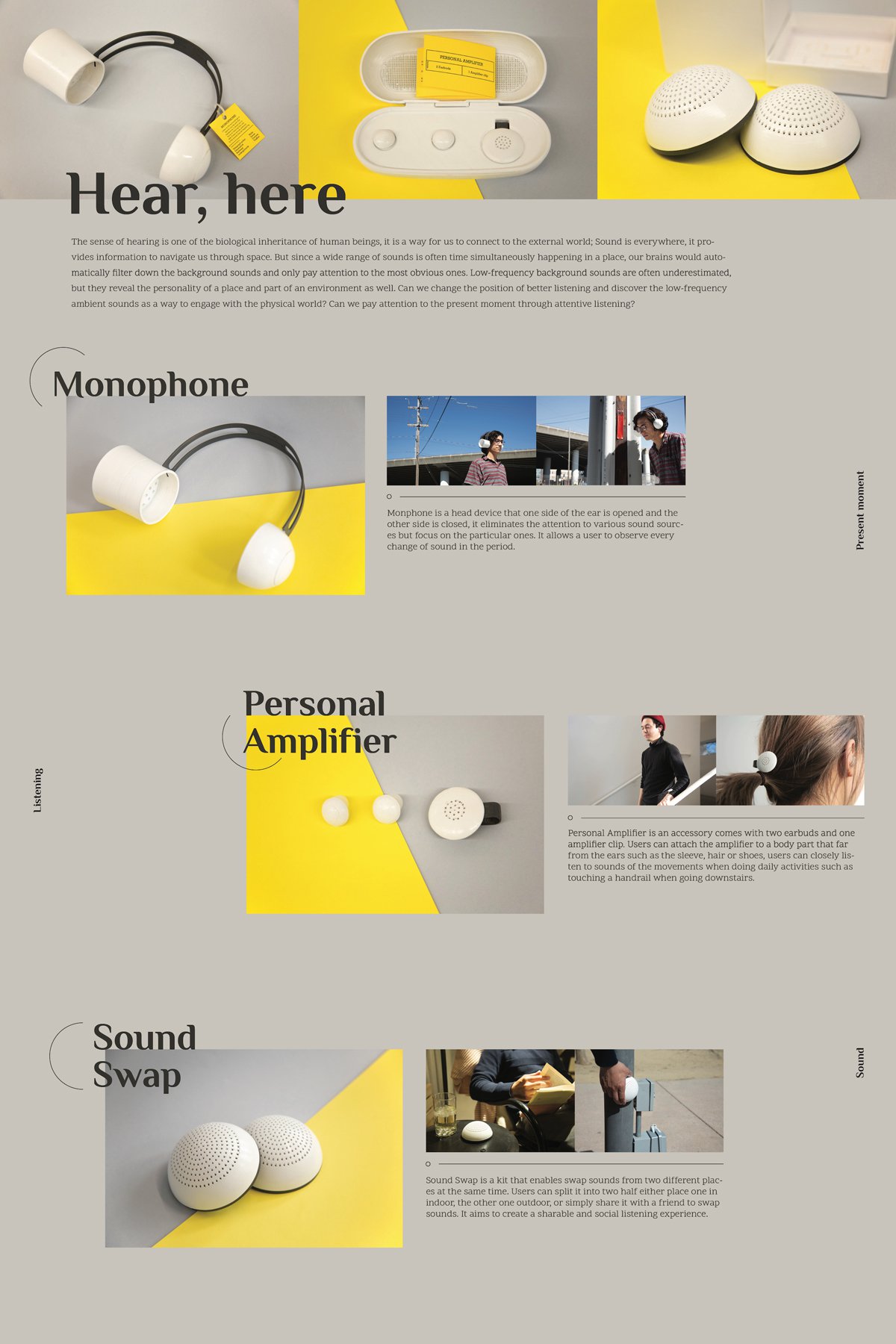MFA Design launches the Design Futures Lab
CCA students, faculty, and the wider design community join together to ask provocative questions that will shape the future.
The emergence of speculative design
From helmets that broadcast visible brainwaves to machines that record and play olfactory narratives, the future is coming and designers are leading the way. Projects like these, which are rooted in the emerging space of speculative design, are unconstrained by market and feasibility concerns. Their focus, instead, is on a near but imagined future where methods for sharing food, space, profits, and power are up for debate. Speculative design asks questions like, “Should all labor be automated?” and “Is privacy already antiquated?” It proposes answers through research and constructed artifacts that simultaneously critique the present and make alternate futures.
“Speculative design questions the power dynamics that we have currently. It’s hard to work on the present and not reinforce the values or power dynamics in play,” says Sara Dean, assistant chair of the MFA Design program at California College of the Arts (CCA). “To speculate is to imagine different scenarios and situations that work can live in.”

Qinqin Yang and Shihan Zhang, TACTAG® - Biological Intimate Memory, 2019. Product poster. Photo courtesy of Shihan Zhang.
MFA Design students lead the way
CCA students have already started to make waves in the provocative arena of speculative design. In 2019 and 2018, MFA Design students won the Emerging Design Award at the prestigious international PRIMER Conference. To provide students with more time, space, and resources for pursuing this work, Sara Dean is launching the new Design Futures Lab in MFA Design this spring.
Open space for questioning and critique
Shuyan Yuan was one of the CCA design students to receive the Emerging Designer Award at the PRIMER Conference. Her winning project, titled Hear, here, reimagines a user’s auditory experience. With speakers that transfer sound from one space to another, as well as amplifiers that bring distant ambient noises close, Hear, here situates listeners in completely new soundscapes.
Hear, here critiques our limited methods for designing sound; questions how we privilege some senses, such as sight, over others, such as sound and smell; and imagines a potential future in which our use of sensory stimulation will significantly expand.
MFA Design Associate Professor Scott Minneman sees the potential for critique as central to design education. He says, “Getting our students thinking deeply about the future and crafting a world that we actually want to live in is perhaps the most important role that a design school can tackle.” Minneman, who is also a research affiliate at the Institute for the Future (IFTF), regularly integrates themes and challenges from his work into his courses at CCA. Minneman’s students have collaborated with him on the IFTF projects Toward an Internet of Actions and The Age of Distributed Superpowers. “It is imperative,” Minneman says, “that design practitioners be ready to sift through the novelty, create compelling new experiences, and ask questions about what we can and should be doing from an ethical and moral perspective.”
“Getting our students thinking deeply about the future and crafting a world that we actually want to live in is perhaps the most important role that a design school can tackle.”
Associate Professor for Graduate Design
Framework for the Design Futures Lab
Incubator, hub, and archive
The lab that Assistant Chair Dean is launching will support, record, and inspire the blossoming of interest and work in the field of speculative design. Rather than taking the form of a defined physical space, the lab will be a collection of work, a network of programmatic support, and an organizing framework under which to house research. The lab will align with specific CCA courses and facilitate partnerships with industry leaders and researchers. Additionally, the lab will offer summer internships, giving students the chance to contribute to faculty research, as well as post-graduate fellowships focused on helping students develop their thesis projects into mature, public-facing works.
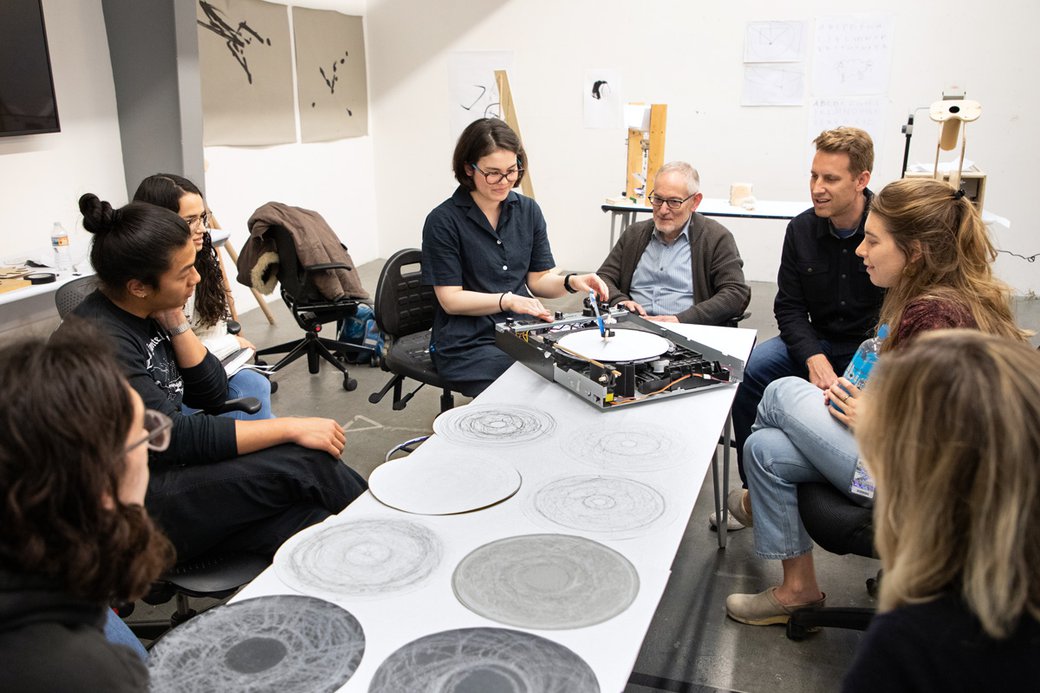
Sarah Bonnickson (MFA Design 2021) demonstrates her drawing machine.
Drawing Machines
MFA Design’s Drawing Machines course is a great example of this kind of alignment. Led by Professor Martin Venesky and Adjunct Professor Matt Johnson, students in the course combine disparate elements—including found technology and custom materials—to deploy assistive and autonomous tools for mark-making. While very much in the present, drawing with machines allows us to entertain how we could collaborate with machines and explore the degree to which we are willing to cede control to them in our work.
Hacking aesthetic outputs
During fall 2019, Sarah Bonnickson (MFA Design 2021) used a multi-disc DVD player, LP turntable, 3D-printed parts, and Arduino code to make a set of arms that produces erratic radial drawings.
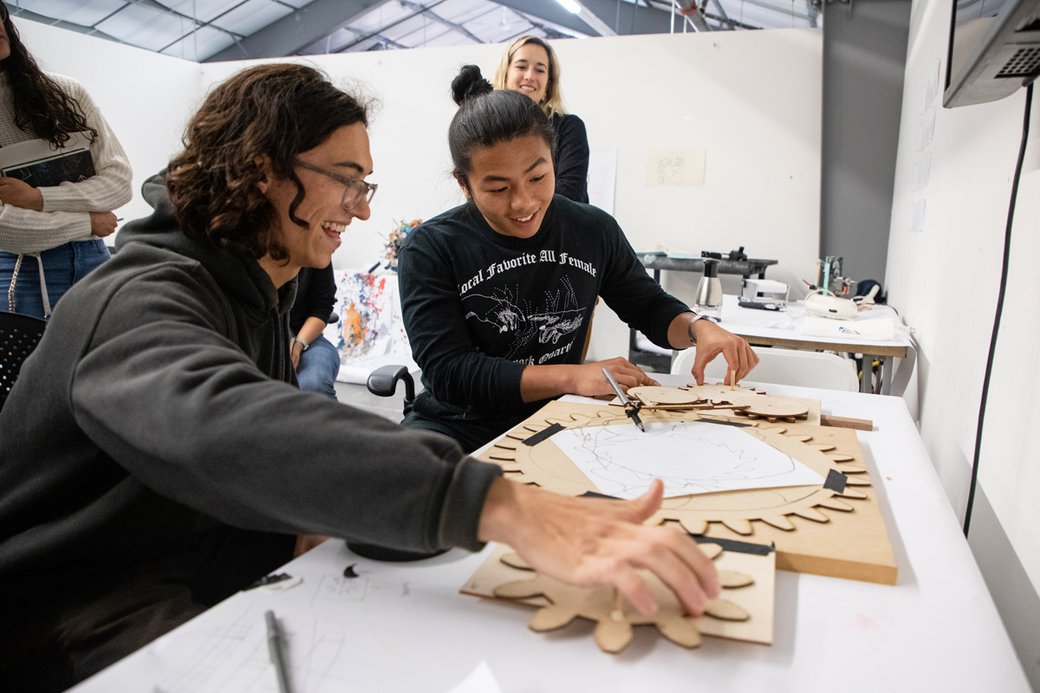
MFA Design students Jason Malik (left) and Tin Dinh (center) draw in collaboration with Dinh’s machine.
Mediated collaboration
Another student, Tin Dinh (MFA Design 2021 and MBA Design Strategy 2022), built a set of laser-cut wooden gears that allows two participants to collaborate on a drawing, resulting in a process that, as he describes it, “confounds any predictable output.”
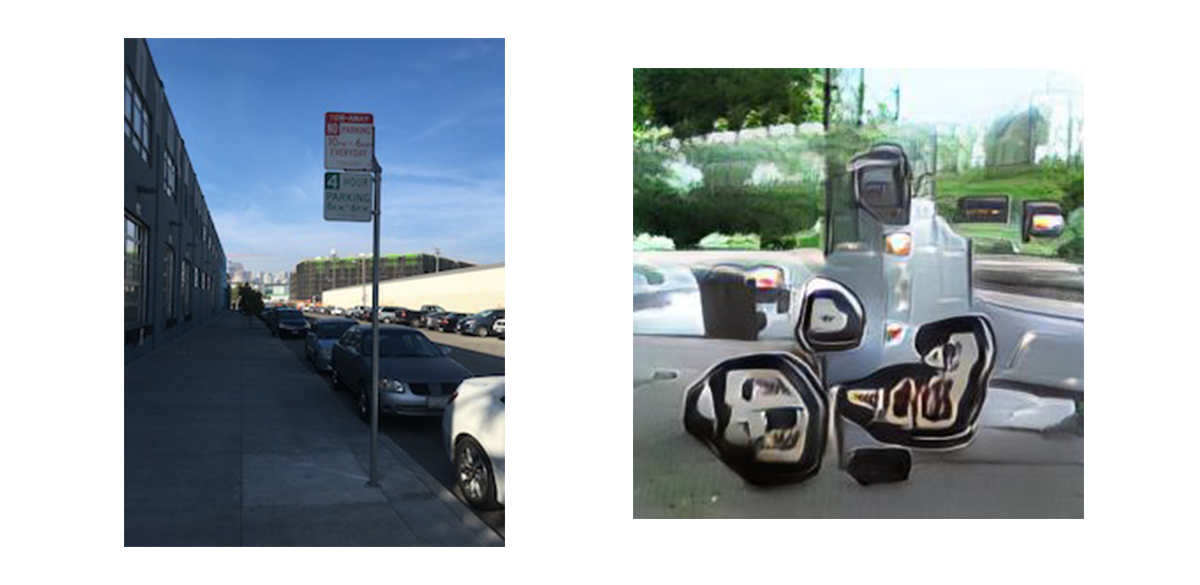
MFA Design student Jason Malik’s piece in dialogue with a Common Objects in Context (COCO) dataset.
Conversing with algorithms
Jason Malik (MFA Design 2021) explores how artificial intelligence recognizes images and words in a text-to-image dialog with a dataset called Common Objects in Context (COCO). On the left side is a photograph Malik took outside on CCA’s campus. After feeding this photograph into the dataset, COCO labeled it as “a car is parked on the side of the road.” Malik then fed this label, or text, back into COCO. The response, on the right side, is generated by the algorithm, but feels like something we might call creative, and certainly doesn’t look like a car. Predictably, the machine masters recognition before generation, not unlike our own learning patterns, and it responds in unpredictable ways to empty or background space. As we teach the program to talk, our language will also shift. Both sides will work to anticipate the codes the other will understand.
Empowering students to be active agents for change
Drawing Machines can be characterized by a raw, experimental aesthetic of hacked mechanics and uncertain outcomes. The project materials are current (or, in many cases, antiquated), but the questions they raise are focused on the future, examining how we want to interact with technology in a rapidly evolving exchange in which all former assumptions about boundaries and desirable outcomes are available for rewriting.
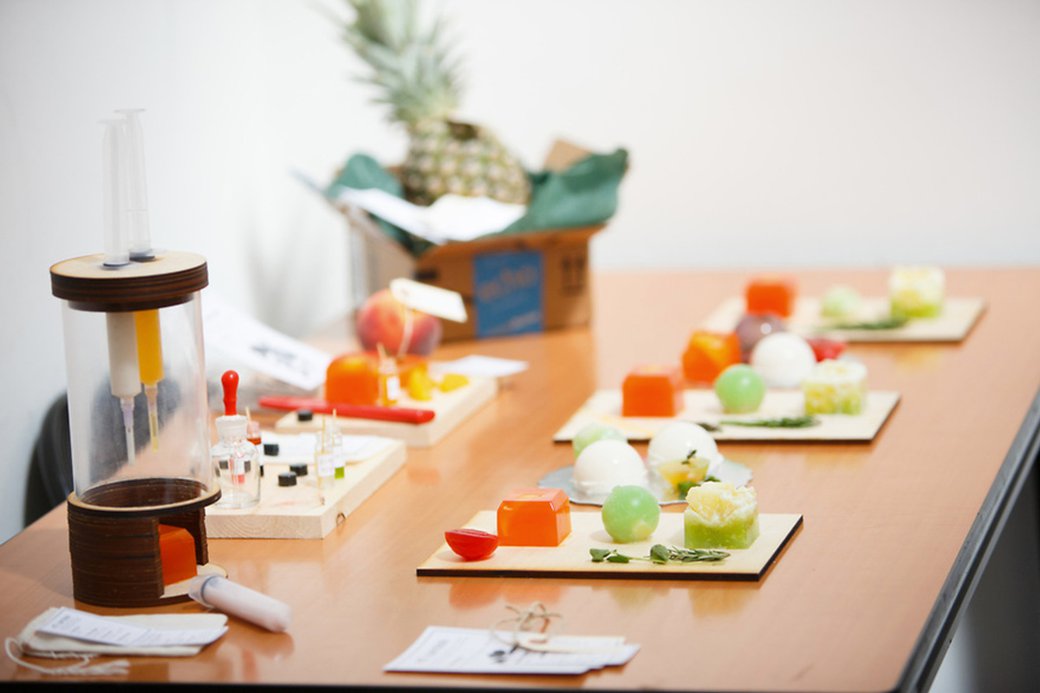
MFA Design student Raquel Kalil’s project “et sens, edible futures,” from 2017, is set 10 years in the future, in 2027, when sensorial eating experiences are commodified because environmental degradation has decreased access to traditional products.
Speculative practice empowers designers to be active instead of reactive in the construction of our future. Alum Raquel Kalil (MFA Design 2018) says, “There is something exhilarating about pushing the boundaries with speculative design: It is a forward-making exercise.” Kalil’s thesis on food packaging evolved when she approached her work through a speculative lens. “By using foresight strategies in design, the [object] invites a conversation that addresses the consequences and implications over the long run,” Kalil says. This kind of work is happening across CCA, from the resource-conscious models being developed in the BFA Fashion Design program, to the responsive environments proposed in the Architecture division, to the work pioneered by the college’s Ecological Practices minor.
Encouraging interactions across disciplines
There are myriad opportunities for the Design Futures Lab to serve as an interactive space between academic disciplines. To begin, Assistant Chair Dean envisions collaborative work in four areas of focus that will shape the future:
- Media and technology
- Materials and manufacturing
- Ecology and adaptation
- Form and aesthetics
Like the autonomous tools for mark-making explored in the Drawing Machines course, these four subject areas allow us to take existing components and imagine how they might function differently in new contexts and in new hands.
Resource-conscious work across the college
Finding speculative work in unexpected spaces
The aesthetics and recognizable qualities of speculative design have been coalesced and defined in large part by Anthony Dunne and Fiona Raby in their book, Speculative Everything: Design, Fiction and Social Dreaming. Speculative work appears in museums, workshops, lectures and books, industry research labs, and, occasionally, unexpected public spaces, as demonstrated by the 99¢ Futures project from the design group Extrapolation Factory. The project’s products are often research heavy and require context and narrative for their value to be understood. The work shares some conceptual overlaps with science fiction and speculative art, but uses design language and form to communicate.
“Everything we do in design is future tense. We only propose things that don’t yet exist.”
MFA Design Assistant Chair
Designers need to imagine alternate futures
Last spring when Bruce Tharp—co-author of the landmark text Discursive Design: Critical, Speculative, and Alternative Things—came to speak as part of CCA’s Design Lecture Series, a student asked, “How do you make a living doing this?” There is often a skeptical response to the practicality of this kind of work and to the idea of designing for an imagined future. Another student asked, “How big is this really? Is it just going on in schools?” While it is a movement and a group of work, strands of speculative design have always been present in the industry.
“Everything we do in design is future tense,” says Assistant Chair Dean. “We only propose things that don’t yet exist. Students often anticipate that employers want what is already happening. That is not the case. The most valuable designers are the ones who can go in and see potential that has not yet been imagined. When we talk to professionals in the technology and design industries, they tell us that they see a need for new types of questions, as well as current market design thinking. Students that can take on critical design questions have the most to offer in the Bay Area market.”
In spring 2020, MFA Design will host a workshop with allied institutions to get outside feedback on the Design Futures Lab’s big questions. In June 2020, during San Francisco Design Week, the Design Futures Lab will launch publicly with an exhibition of work, as well as a short symposium and workshop on campus. The energy and excitement around the lab emanates from and is characteristic of the MFA Design program. The engaged pursuit of these abstract futures positions CCA students and faculty to have a real voice in the conversations that make the future.

Push boundaries and lead conversations that transform culture
